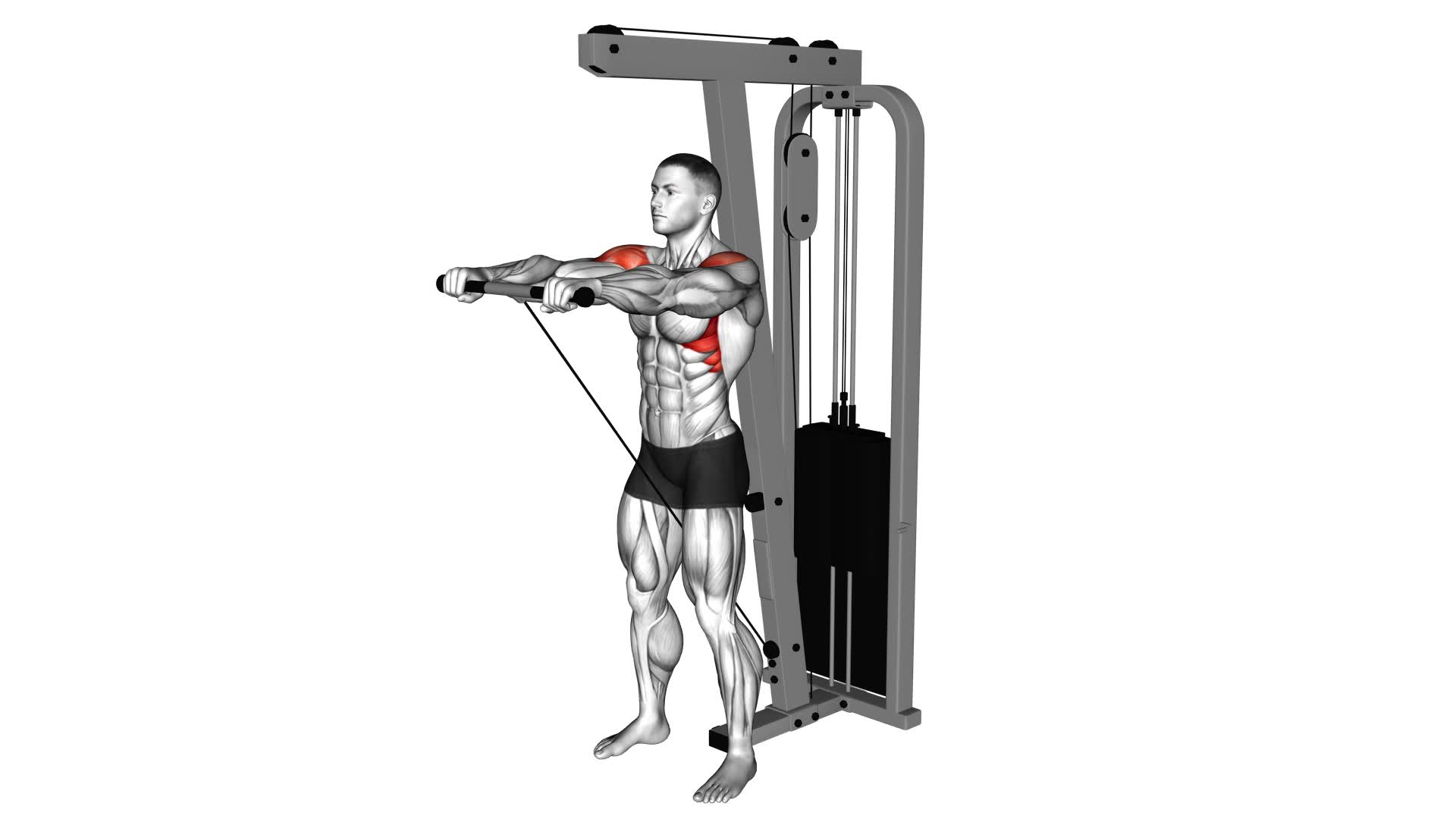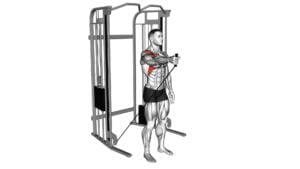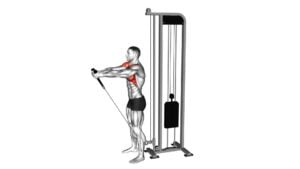Cable Front Raise – Video Exercise Guide & Tips

Are you looking to strengthen your shoulder muscles? Look no further than the cable front raise.
Watch This Exercise Video
In this video exercise guide, we'll show you the proper form and technique to get the most out of this exercise.
You'll also learn variations to keep your routine interesting and avoid common mistakes.
Plus, we'll share tips to help you progress and increase intensity.
Get ready to elevate your shoulder workout with the cable front raise!
Key Takeaways
- Cable front raises strengthen shoulder muscles, including the anterior deltoids.
- Cable front raises improve shoulder stability and performance in activities like throwing and lifting.
- Cable front raises provide constant tension for greater muscle activation and growth.
- Cable front raises allow for a greater range of motion compared to dumbbell exercises.
Benefits of Cable Front Raise
You can maximize your shoulder strength and stability by incorporating cable front raises into your workout routine. Cable front raises target several key muscles in your shoulders, including the anterior deltoids, the muscles located at the front of your shoulder. These muscles are responsible for raising your arms forward and are crucial for movements like throwing, pushing, and lifting. By strengthening these muscles, you can improve your overall shoulder stability and enhance your performance in various activities.
Cable front raises offer a unique advantage over other shoulder exercises because they provide constant tension throughout the entire range of motion. This constant tension helps to engage and activate the targeted muscles more effectively, leading to greater muscle activation and growth. Additionally, cable front raises allow for a greater range of motion compared to traditional dumbbell exercises, allowing you to challenge your muscles in different ways.
Incorporating cable front raises into your routine can also help to improve shoulder stability. These exercises require you to maintain control and stability throughout the movement, which can help to strengthen the muscles that support the shoulder joint. This increased stability can't only prevent injuries but also enhance your ability to perform other upper body exercises with proper form and technique.
Proper Form and Technique
To perform the cable front raise with proper form and technique, there are a few key points to keep in mind.
First, ensure that your shoulders are properly aligned throughout the exercise to avoid straining the muscles.
Secondly, position your elbows in a stable position to maintain control and prevent injury.
Finally, practice proper breathing techniques to help maintain control and stability throughout the movement.
Shoulder Alignment During
Maintaining proper shoulder alignment is crucial for performing the cable front raise exercise effectively. When it comes to shoulder alignment, two key factors to consider are shoulder mobility and shoulder stability.
Proper shoulder mobility allows for a full range of motion during the exercise, while shoulder stability ensures that the shoulder joint is stable and secure.
To maintain proper shoulder alignment, start by standing tall with your feet shoulder-width apart and your core engaged. Keep your shoulders relaxed and down, avoiding any shrugging or hunching.
Throughout the exercise, make sure to avoid excessive swinging or momentum, as this can compromise shoulder alignment.
Elbow Positioning for Stability
Proper elbow positioning is essential for maintaining stability and executing the cable front raise exercise effectively. To ensure elbow stability and maximize shoulder mobility during this exercise, follow these guidelines:
- Keep your elbows slightly bent throughout the movement to avoid locking them out, which can strain the joints.
- Maintain a neutral wrist position, avoiding excessive flexion or extension, to promote proper alignment and reduce the risk of injury.
- Engage your core and maintain a stable torso to enhance overall stability and prevent unnecessary movement.
- Avoid swinging or using momentum to lift the weight, as this can compromise form and reduce the effectiveness of the exercise.
Breathing Techniques for Control
For better control and proper form, focus on your breathing during the cable front raise exercise. Breathing plays a crucial role in enhancing muscle activation and maintaining stability throughout the movement.
As you lift the cables in front of you, inhale deeply before starting the upward motion. Exhale slowly and steadily as you raise the cables, engaging your core and stabilizing your body. This controlled breathing technique helps to prevent unnecessary tension in your muscles and ensures that you maintain proper form throughout the exercise.
By incorporating specific breathing exercises into your cable front raise routine, you can optimize muscle activation and improve your overall performance.
Now that you understand the importance of proper breathing, let's explore some variations and modifications you can incorporate into your cable front raise workout.
Variations and Modifications
Now let's talk about the different grip options and customizable resistance levels that you can use for cable front raises.
By changing your grip, you can target different muscles in your shoulders and arms.
Additionally, the cable machine allows you to easily adjust the weight or resistance, making it suitable for individuals of all fitness levels.
Different Grip Options
To add variety to your cable front raise, you can experiment with different grip options. This not only helps to keep your workout interesting, but it also targets different muscles and provides additional benefits. Here are four alternate grips that you can try:
- Overhand Grip: This is the most common grip used in the cable front raise exercise. It targets your anterior deltoids and helps to improve shoulder stability.
- Underhand Grip: By using an underhand grip, you engage your biceps more during the exercise. This grip variation is great for those looking to incorporate grip strength training into their routine.
- Neutral Grip: With a neutral grip, your palms face each other. This grip option targets your middle deltoids and can help to improve overall shoulder strength.
- Wide Grip: By widening your grip on the cable handle, you increase the range of motion and engage your shoulder muscles in a different way. This grip variation is great for targeting the outer deltoids.
Customizable Resistance Levels
To continue customizing your cable front raise, you can adjust the resistance levels to suit your individual needs and goals. Customizable resistance allows you to challenge yourself or modify the exercise based on your fitness level.
There are several equipment options available to achieve this. If you find that the current resistance is too light, you can increase it by adding weight plates or adjusting the cable machine's settings.
On the other hand, if the resistance feels too heavy, you can decrease it by using lighter weights or adjusting the cable machine accordingly.
Common Mistakes to Avoid
Avoid these common mistakes when performing the cable front raise exercise to maximize your results and prevent injury. To ensure you're getting the most out of your workout and protecting your shoulders, be mindful of the following:
- Using too much weight: It can be tempting to go heavy, but using excessive weight can compromise your form and put unnecessary strain on your shoulders. Start with a lighter weight and gradually increase as you become more comfortable with the movement.
- Raising your arms too high: While it's important to lift your arms in front of you, avoid raising them above shoulder level. This can lead to impingement and shoulder pain. Focus on a controlled movement, keeping your arms parallel to the floor.
- Swinging or using momentum: This is a common mistake that takes away from the effectiveness of the exercise. Instead, maintain a slow and controlled motion, engaging your shoulder muscles throughout the entire range of motion.
- Neglecting proper posture: Good posture is crucial for proper form and shoulder stability. Avoid rounding your shoulders or arching your back. Stand tall, engage your core, and maintain a neutral spine throughout the exercise.
Tips for Progression and Increasing Intensity
To continue maximizing your results and preventing injury, focus on gradually increasing the intensity of your cable front raise exercise.
Progression techniques play a crucial role in challenging your muscles and promoting growth. One effective way to increase the intensity is by adding weight to the exercise. Start with a weight that's manageable but challenging, and as you become stronger, gradually increase the load. This can be done by using heavier dumbbells or adjusting the weight stack on the cable machine. Aim to increase the weight by small increments each week or every few weeks to allow your muscles to adapt and progress.
Additionally, you can increase the intensity by performing more sets or repetitions of the exercise. By gradually adding more weight and volume to your cable front raise, you'll continue to challenge your muscles and stimulate further growth.
With these progression techniques in mind, let's move on to the next section and explore a sample cable front raise workout routine.
Sample Cable Front Raise Workout Routine
To begin your sample cable front raise workout routine, make sure to choose an appropriate weight that challenges your muscles without sacrificing form. Here's a simple and effective routine to help you get started:
- Standard Cable Front Raise: Start with your feet shoulder-width apart and grasp the cable handles with an overhand grip. Keep your core engaged and lift the handles straight in front of you, stopping when they reach shoulder level. Slowly lower them back down and repeat for the desired number of reps.
- Alternating Cable Front Raise: Similar to the standard front raise, but this time, lift one arm at a time while keeping the other arm at your side. Alternate between arms for each repetition.
- Single Arm Cable Front Raise: Stand with your feet shoulder-width apart and hold one cable handle with an overhand grip. Lift the handle straight in front of you, stopping at shoulder level. Lower it back down and repeat on the other side.
- Cable Front Raise with External Rotation: Start with your feet shoulder-width apart and hold the cable handles with an overhand grip. Lift the handles straight in front of you, but as you reach shoulder level, rotate your arms outward until your palms are facing up. Lower the handles back down and repeat.
Incorporating these cable front raise variations and effective modifications into your workout routine will help target different muscles and keep your routine challenging and exciting.
Frequently Asked Questions
How Many Sets and Reps Should I Do for Cable Front Raises?
For cable front raises, the number of sets and reps you should do depends on your fitness level and goals. Generally, it's recommended to start with 2-3 sets of 8-12 reps. This range allows you to build strength and muscle endurance.
However, you can also vary the sets and reps to challenge your muscles in different ways. For example, you can try higher reps with lighter weights or lower reps with heavier weights to target different muscle fibers.
Can I Use Dumbbells Instead of a Cable Machine for Front Raises?
Yes, you can definitely use dumbbells instead of a cable machine for front raises. Dumbbell front raises are an effective alternative that targets your shoulder muscles.
However, it's worth noting that using a cable machine has its advantages. The cable provides constant tension throughout the movement, which can help to further engage your muscles.
Ultimately, the choice between dumbbells and a cable machine depends on your preference and the equipment available to you.
Is It Normal to Feel Shoulder Discomfort While Performing Cable Front Raises?
It's not uncommon to experience shoulder discomfort during cable front raises if your shoulder mobility is limited or if you're not using proper form.
Make sure to warm up your shoulders before starting the exercise and focus on maintaining good posture throughout.
Engage your core and avoid any jerky movements.
If the discomfort persists, it may be best to consult a fitness professional or a healthcare provider for further guidance.
How Often Should I Incorporate Cable Front Raises Into My Workout Routine?
To incorporate cable front raises into your routine, consider the frequency that works best for you. Cable front raises target your shoulder muscles, helping to strengthen and tone them. Depending on your fitness goals and the intensity of your workouts, you can perform cable front raises 1-3 times a week.
Remember to start with lighter weights and gradually increase to avoid shoulder discomfort. Adding cable front raises to your routine can improve overall shoulder strength and stability.
Are There Any Alternative Exercises That Target the Same Muscles as Cable Front Raises?
If you're looking for alternative exercises that target the same muscles as cable front raises, there are a few options you can try.
Consider incorporating dumbbell front raises or barbell front raises into your workout routine. These exercises can also activate your shoulder muscles effectively.
Remember to maintain proper form and start with lighter weights to avoid injury.
Adding variety to your routine can help you maximize muscle activation and achieve your fitness goals.
Conclusion
In conclusion, the cable front raise is a highly effective exercise for targeting the front deltoids and improving shoulder strength and stability.
By following proper form and technique, avoiding common mistakes, and gradually increasing intensity, you can maximize the benefits of this exercise.
Incorporating cable front raises into your workout routine can help you achieve stronger and more defined shoulders.

Author
Years ago, the spark of my life’s passion ignited in my mind the moment I stepped into the local gym for the first time. The inaugural bead of perspiration, the initial endeavor, the very first surge of endorphins, and a sense of pride that washed over me post-workout marked the beginning of my deep-seated interest in strength sports, fitness, and sports nutrition. This very curiosity blossomed rapidly into a profound fascination, propelling me to earn a Master’s degree in Physical Education from the Academy of Physical Education in Krakow, followed by a Sports Manager diploma from the Jagiellonian University. My journey of growth led me to gain more specialized qualifications, such as being a certified personal trainer with a focus on sports dietetics, a lifeguard, and an instructor for wellness and corrective gymnastics. Theoretical knowledge paired seamlessly with practical experience, reinforcing my belief that the transformation of individuals under my guidance was also a reflection of my personal growth. This belief holds true even today. Each day, I strive to push the boundaries and explore new realms. These realms gently elevate me to greater heights. The unique combination of passion for my field and the continuous quest for growth fuels my drive to break new ground.







